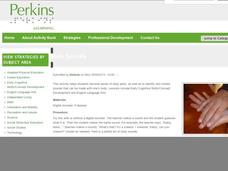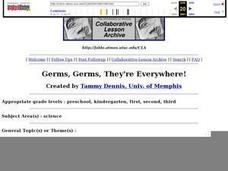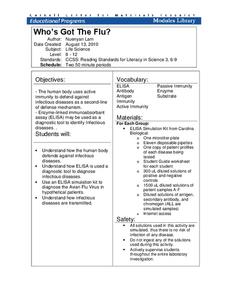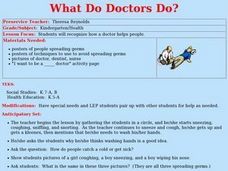Curated OER
Big Sneeze
Students discuss germs and how they get colds. They demonstrate the importance of covering their mouths while sneezing and what happens when the don't. They practice sneezing and coughing with a tissue.
Nemours KidsHealth
Colds and Flu: Grades 3-5
Two lessons from Kids Health Network aid in the prevention of cold and flu. The first lesson challenges scholars to read articles, discuss their findings, then create a PSA for proper prevention methods. The second lesson includes a game...
Curated OER
Cover Your Mouth Please!
Second graders investigate how to slow the spread of germs from coughing and sneezing. In this illness prevention lesson, 2nd graders talk about why people cough and sneeze before telling about ways to prevent the spread of germs. They...
Curated OER
Watch Germs Spread
Students demonstrate how germs spread from one person to another. They hide a small quantity of flour or cornstarch in their hand and then pretend to sneeze or cough into the hand. they shake hands with a child sitting nearby. They...
Perkins School for the Blind
Learning to Identify Sounds Made by the Body
Sneeze, snap, tap, and whistle; Did I do that? Explore the parts and sounds of the human body with your learners with visual impairments. First you'll name the parts of the body, make a sound with each part, and then have the class guess...
Nemours KidsHealth
Colds and Flu: Grades K-2
Two lessons identify three steps to prevent catching a common cold or the flu. The first lesson turns a familiar song into a friendly reminder to wash hands, cover your coughs, sneezes, and keep hands off your face. Lesson two challenges...
Curated OER
The Human Body
Explore the human body through hands-on activities. Young learners will trace their bodies and place cut out body organs in the proper place, print patterns using cut fruit, sing songs about good nutrition, and use their five senses...
Curated OER
Germs: Learning Not to Share
Students have cinnamon sprinkled onto their hands and walk around the room touching objects within their reach. Students observe all of the objects containing cinnamon fingerprints to visualize where and how germs are spread.
Curated OER
Making Germ Monsters
Students explore germs. In this literacy and health lesson, students listen to the book Germs! Germs! Germs! by Bobbi Katz and discuss methods that prevent the spreading of germs. Students cut symmetrical shapes out of construction paper...
Curated OER
Good Health Manners
Pupils read and discuss a list of Good Health Manners and examine how to avoid the flu. They complete a worksheet, and write why it is important to follow good health manners.
Centers for Disease Control and Prevention
Teach Mrs. Jones' Class about Microbes
During a biology lesson, scholars research microbes, design a lesson plan using an outline, and present the lesson to the class.
PBS
Stories of Painkiller Addiction: Learning About Opioids
Feeling high is not the only side effect of abusing prescription opioids. Middle and high schoolers learn more about specific painkillers, including Fentanyl, Oxycodone, and Clonazepam, as well as their common brand names and extensive...
Peel-Public Health
What Is Respiratory Infection?
Empower your pupils to be germ stoppers! The heart of these lessons lies in stopping the spread of germs and keeping clean hands in order to prevent cases like a respiratory infection. It includes a game to simulate how germs can spread...
Curated OER
Germs, Germs, They're Everywhere!
Youngsters recognize that germs are everywhere, and can make us sick. They identify ways that germs can be spread, see how they can prevent the spreading of germs, and learn appropriate hand washing techniques.
Centers for Disease Control and Prevention
Understanding the Epidemiologic Triangle through Infectious Disease
Introduce infectious diseases and the epidemiologic triangle. A helpful resource describes the agent, host, and environment from the three vertices as well as the time factor, which is in the middle. Scholars complete a simple...
Cornell University
Who’s Got The Flu?
Become an immunologist for the day. Scholars elicit the use of the enzyme-linked immunoabsorbent assay (ELISA) to diagnose an infectious disease. Through the process, they learn about the immune system response to infectious diseases.
Curated OER
What Do Doctors Do?
Students recognize how doctors help people and about germ spreading.
Utah LessonPlans
Disease Prevention and HIV/AIDS Education - First Grade
Identify behaviors that promote health and demonstrate personal hygiene.
Curated OER
Good Health Manners
Students review what they know about good manners and create a list of good manners. They read a list of good manners and discuss why they are important. They practice good manners and explain how they will keep the flu away.
Curated OER
Listening to Gather Evidence in a Reading Selection
Fourth graders explore an Ethiopian folktale, "Fire on the Mountain." In this literature lesson, 4th graders evaluate and record the evidence, as well as make predictions about what they think will happen. Students evaluate other groups...
Curated OER
Let's Learn the Flu Facts
Learners examine the difference between a cold and the flu. They discuss the symptoms of colds and flu, complete a cloze activity, and discuss how to stay healthy.
Curated OER
Household Pests
Identify methods that prevent food-borne illnesses and contamination. National Standard 14.4.1 Identify food-borne illness Identify types of food-borne illness and their symptoms: botulism, e-coli, hepatitis, salmonella, staphylococci...
Curated OER
Floating and Falling Flows
Students discover fluid dynamics related to buoyancy through experimentation and optional photography. Using one set of fluids, they make light fluids rise through denser fluids. Using another set, they make dense fluids sink through a...
Curated OER
Pandemic Flu
Students review the difference between viruses and bacteria, and provide examples of illnesses that each can cause. To help students comprehend how quickly an influenza infection can spread, they perform an activity. They are placed in...

























